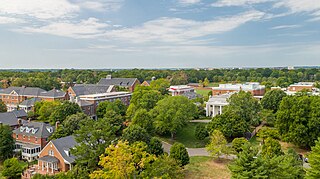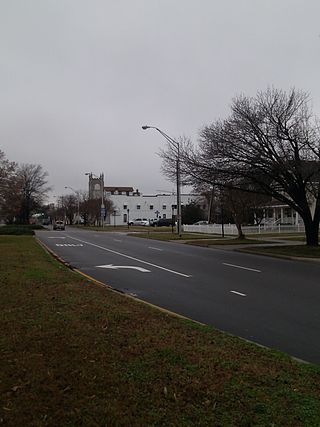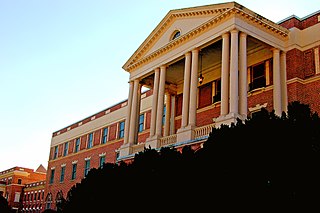
Lynchburg is an independent city in the Commonwealth of Virginia in the United States. First settled in 1757 by ferry owner John Lynch, the city's population was 79,009 at the 2020 census, making Lynchburg the 11th most populous city in Virginia. Located in the foothills of the Blue Ridge Mountains along the banks of the James River, Lynchburg is known as the "City of Seven Hills" or the "Hill City". In the 1860s, Lynchburg was the only city in Virginia that was not recaptured by the Union before the end of the American Civil War.

Danville is an independent city in the Commonwealth of Virginia in the United States. The city is located in the Southside Virginia region and on the fall line of the Dan River. It was a center of tobacco production and was an area of Confederate activity during the American Civil War, due to its strategic location on the Richmond and Danville Railroad. In April 1865 it briefly served as the third and final capital of the Confederacy before its surrender later that year.

Stephen Cambreleng Cowper is an American Democratic politician who was the sixth governor of Alaska from 1986 to 1990. He was governor during the 1989 Exxon Valdez oil spill.
Hollins University is a private university in Hollins, Virginia, United States. Founded in 1842 as Valley Union Seminary in the historical settlement of Botetourt Springs, it is one of the oldest institutions of higher education for women in the US.
Randolph–Macon College is a private liberal arts college in Ashland, Virginia. Founded in 1830, the college has an enrollment of more than 1,500 students. It is the second-oldest Methodist-run college in the country, and the oldest in continuous operation. The college primarily offers bachelor's degrees.

Episcopal High School, founded in 1839, is a boarding school located in Alexandria, Virginia. The Holy Hill 130-acre (53-hectare) campus houses 440 students from 31 states, the District of Columbia and 16 countries. The school is 100-percent boarding and is the only all-boarding school of its caliber located in a major metropolitan area.

Berkley was an incorporated town in Norfolk County, Virginia. Chartered by an Act of Assembly in 1890, the Town of Berkley was located directly across the Eastern Branch Elizabeth River from the City of Norfolk in the South Hampton Roads area.

The Virginia State Capitol is the seat of state government of the Commonwealth of Virginia, located in Richmond, the state capital. It houses the oldest elected legislative body in North America, the Virginia General Assembly, first established as the House of Burgesses in 1619.

Woodberry Forest School is a private, all-male boarding school located in Woodberry Forest, Madison County, Virginia, in the United States. Woodberry's current enrollment is 391. Students come from 34 U.S. states, Washington, D.C., and 36 countries. The school's endowment and managed funds total $432,000,000 as of June 30, 2023. Comprehensive tuition for 2023–2024 is $65,350; 41% of the students receive financial aid.

William Munford Tuck was an American lawyer and lieutenant in the Byrd Organization, who served as the 55th Governor of Virginia from 1946 to 1950 as a Democrat, and as a U.S. Congressman from 1953 until 1969.

Virginia University of Lynchburg (VUL) is a private historically black Christian university in Lynchburg, Virginia. The university is accredited by the Transnational Association of Christian Colleges and Schools and offers instruction and degrees, primarily in religious studies, including a Doctorate of Ministry program. The campus is a historic district listed on the National Register of Historic Places.
This is an incomplete list of historic properties and districts at United States colleges and universities that are listed on the National Register of Historic Places (NRHP). This includes National Historic Landmarks (NHLs) and other National Register of Historic Places listings. It includes listings at current and former educational institutions.

Colonel Chiswell Dabney Langhorne was an American railroad industrialist. He was the father of Nancy Witcher Langhorne and the maternal grandfather of both Joyce Grenfell and Michael Langhorne Astor.

St. Christopher's School is an American private college preparatory school for boys located in Richmond, Virginia. The school is listed on the National Register of Historic Places.

Point of Honor is an historic home, now a city museum, located in Lynchburg, Virginia. The property has commanding views of the city and the James River. Its name originated due to the land on which it is built being used as a clandestine dueling ground.

Hardy Cross Dillard was an American jurist who served as a judge on the International Court of Justice from 1970 to 1979, as a judge appointed by Queen Elizabeth II to a court of arbitration concerning the Beagle Channel islands dispute, Dean of the University of Virginia School of Law (1963–1968), legal adviser to the High Commissioner for Germany (1950), first director of the National War College (1946), and as a colonel in the U.S. Army during World War II (1941–1946). During World War II, Dillard served as deputy chief of staff for civil affairs (G5) in the China Command, Commander of the Civil Affairs Staging Area at the Presidio of Monterey where he oversaw preparation and planning for the Occupation of Japan and as commander of the European Civil Affairs Training Division of SHAEF in preparation for Operation Overlord. Previously, he initiated and served as director of the School of Military Government.

Blackstone College for Girls was a private, religious school for young women in Blackstone, Nottoway County, in the U.S. state of Virginia. The school operated under the auspices of the Virginia Conference of the Methodist Episcopal Church, South between 1894 and 1950. The Virginia Department of Historic Resources acknowledged the significance of the site by erecting historical marker number K 174 in 1996. Blackstone College is also designated as a site on the Civil Rights in Education Heritage Trail. The school buildings still stand. Since 1955, the Virginia United Methodist Church has used the former school buildings as a conference center.

Langhorne House, also known as the Gwynn Apartments, is an historic late 19th-century house in Danville, Virginia later enlarged and used as an apartment house. Its period of significance is 1922, when Nancy Langhorne Astor, by then known as Lady Astor and the first woman to sit in the British Parliament, came to Danville to visit her birthplace and promote Anglo-American relations.

Frederick Hiester Brooke was an American architect from Washington, D.C., who designed houses, schools, churches, and embassies during his 40-year career. A native of Pennsylvania, Brooke studied in the US and France before opening his practice in the nation's capital. He served overseas during World War I and would later design a memorial in West Potomac Park which honors local soldiers. He was an active member in several professional organizations, most notably the American Institute of Architects. Brooke's wife, Henrietta, served as president of the Girl Scouts in the 1930s. Among Brooke's notable works are Dumbarton Oaks, the District of Columbia War Memorial, the Sulgrave Club and the British Ambassador's residence, which he codesigned with Edwin Lutyens.






















